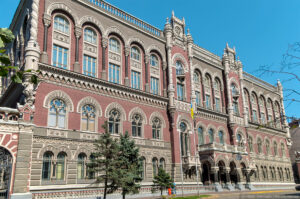
The National Bank of Ukraine has applied to PJSC “European Insurance Alliance” (Kiev) a measure of influence in the form of a fine of UAH 100 thousand for submitting reports to the regulator with violation of deadlines. Such decision was taken by the Committee for Supervision and Regulation of Non-banking Financial Services Markets on December 15, 2025, based on the results of the on-site supervision of the non-banking financial services market.
The company is obliged to pay the fine within one month from the date of entry into force of this decision.
PJSC “European Insurance Alliance” was founded on September 22, 1994. The Company is a member of the Motor (Transport) Insurance Bureau of Ukraine, the League of Insurance Organizations of Ukraine and the Nuclear Insurance Pool of Ukraine.
The company has a license of the NBU dated April 25, 2024 to carry out insurance activities in 16 classes, in particular property insurance, car insurance, liability insurance, health insurance and the like.
The authorized capital amounts to UAH 55 mln.

The National Bank of Ukraine has withdrawn the license for insurance activities and excluded from the State Register of Financial Institutions ALC Insurance Company “Garant & Ya” (Lviv) on the basis of the submitted application.
As reported, the NBU on July 18, 2025 granted to ALC “IC ”Garant & Ya” permission to exit the market by fulfilling the insurance portfolio and coordinated to this insurer the plan of exit from the market by fulfilling the insurance portfolio.
According to the company’s statements for the nine months of 2025, its insurance portfolio was formed by 100% of CASCO. The volume of insurance premiums of the company in the specified period amounted to UAH 14,312 million, insurance payments – UAH 23,437 million.
“The insurer adhered to solvency requirements. As of October 1, 2025 he has no obligations under insurance and reinsurance contracts,” – is emphasized in the information.
Insurance company “Garant and I” works in the insurance market since 2010. Since July 2011, the head office of the company was located in Lviv.
Authorized capital is UAH 33 mln.

The National Bank of Ukraine for violation of legal requirements in the sphere of prevention and counteraction to legalization of proceeds of crime and currency legislation in October 2025 applied to seven banks measures of influence, including fines for the total amount of UAH 205.8 million. According to the publication on the regulator’s website, the largest fines received banks Alliance – UAH 83.5 million, MTB – UAH 78.2 million, Universal, on the basis of which operates mono, – UAH 27.3 million and Ukrsibbank – UAH 11.5 million.
As noted by the National Bank, Alliance Bank was fined UAH 67.6 million for improper organization and conduct of primary financial monitoring (internal documents and procedures, risk management, application of risk-oriented approach, verification of clients, provision of reliable information to NBU requests). Separately, a fine of UAH 15.9 million was imposed for violations of customer due diligence, enhanced measures against high-risk customers, documentation of AML/CFT activities and work with customers related to politically exposed persons.
In addition, the bank received a written warning for failing to include in customer questionnaires data confirmed by available documents.
MTB Bank was fined UAH 75.0 million for failure to comply with the risk-oriented approach, risk management (including remote technologies and new products) and customer due diligence. A separate fine of UAH 3.2 mln was imposed for violation of currency supervision requirements, in particular, untimely identification of currency transactions indicator and shortcomings in analyzing and verifying documents on currency transactions. At the same time, the bank received a written warning for shortcomings in the development and updating of internal documents on AML/CFT issues.
According to the release, Universal Bank was fined UAH 27.3 million for improper customer due diligence, deficiencies in risk management procedures and violation of the procedure for informing the specially authorized body about transactions of customers with frozen assets. In addition, the bank received a written warning for shortcomings in fixing events in the automation system.
As reported by the National Bank, Ukrsibbank must pay UAH 11.0 million for improper customer due diligence and shortcomings in risk-oriented approach, as well as UAH 0.5 million for violation of requirements for notification of the specially authorized body on threshold financial transactions. At the same time, the bank received a written warning for shortcomings in the development of internal documents on AML/CFT issues.
RVS Bank, which the National Bank this week recognized as insolvent, was fined UAH 3.8 mln for violation of risk-oriented approach requirements.
Cominbank was fined UAH 1.1 mln for untimely notification of threshold financial transactions and improper establishment of high risk level in relation to clients.
Idea Bank has to pay UAH 0.5 million fine for untimely execution of the decision on suspension of operations and untimely notification of the specially authorized body about the balance of funds on the client’s account.
In addition to banks, the penalties were also applied to four non-banking financial institutions.
NovaPay Credit LLC from NovaPay Group was fined UAH 255 thousand for improper customer verification and deficiencies in risk-oriented approach. At the same time, the company received a written warning for shortcomings in the development of internal documents on AML/CFT issues.
LLC “FC ”Mustang Finance”, which the National Bank in early November revoked the license, was fined for UAH 731 thousand for shortcomings in internal documents on AML/CFT issues, failure to provide reliable information on the requests of the NBU and violation of the procedure for the formation of statistical reporting.
LLC FC Abecor should pay UAH 595 thousand for improper risk management, violation of requirements for identification and verification of clients, monitoring of financial transactions and submission of reliable information to the regulator.
Alliance Capital Group FC LLC must pay a UAH 17 thousand fine for making material errors in statistical reporting on currency transactions.

Last week, the National Bank of Ukraine (NBU) reduced its sale of dollars on the interbank market by $131.6 million, or 17.9%, to $602.7 million, while the weakening of the hryvnia slowed to 12.8 kopecks from 37.4 kopecks a week earlier.
According to information from the National Bank, during the first four days of last week, the average daily negative balance of currency purchases and sales by legal entities increased to $74.2 million from $36.6 million during the same period a week earlier, totaling $297 million.
At the same time, on the cash market, on the contrary, there was a decrease in currency purchases by the population: from Saturday to Thursday, the negative balance amounted to $21.3 million against $29.6 million the week before last. The purchase of non-cash currency exceeded its sale during all these days.
The official hryvnia-dollar exchange rate, which started last week at 41.6027 UAH/$1, weakened to 41.7607 UAH/$1 over three days but ended the week at the same level.
On the cash market, the dollar exchange rate over the past week fluctuated around the official rate of 41.7565 UAH/$1, and the hryvnia weakened by about 25 kopecks to the following levels: purchase – about 41.70 UAH/$1, and sale – about 41.80 UAH/$1.
At the end of last week, Bloomberg reported pressure from the International Monetary Fund to increase the pace of hryvnia devaluation, but there is no information on the impact of this factor yet, except that on the first trading day of this week, the hryvnia fell slightly to 41.7624 UAH/$1.
“The Ukrainian currency market continues to be influenced by the National Bank of Ukraine’s strategy of controlled flexibility… Since the beginning of October, the hryvnia has been gradually weakening against the dollar. The exchange rate on the cash market is changing at a similar pace,” experts from KYT Group, a major player in the cash currency exchange market, described the situation.
They added that there has been a noticeable increase in demand on the interbank market in October, and the NBU has been forced to increase its interventions. According to experts, this trend is seasonal on the one hand, as companies’ need for currency to make payments increases in the fall, and on the other hand, an additional factor affecting the hryvnia was the intensification of shelling of Ukraine’s energy and gas infrastructure, which led to an increase in imports of gas and energy equipment.
“In the short term (1–1.5 weeks): the base range is 41.4–41.9 UAH/$1, with a probable tendency toward the upper limit of the forecast,” according to the forecast for the cash market provided by KYT Group.
In the medium term (2–3 months), according to its experts, the exchange rate will be in the range of 41.30–42.00 UAH/$1. They believe that if the Fed goes ahead with an October rate cut and the risks of a trade war between the US and China weaken, the fundamental movement of the dollar on the international market may strengthen, which will also affect the exchange rate in Ukraine. However, the domestic Ukrainian context of expectations of continued large-scale shelling of infrastructure and a deterioration in the energy sector, as well as the high demand for growth in import volumes, may contribute to a more rapid strengthening of the dollar on the Ukrainian currency market.
“In the long term (6+ months): the scenario of a gradual devaluation of the hryvnia remains. Provided that international aid continues to flow in at a steady pace, the benchmark is 43.20-44.40 UAH/USD until mid-2026, taking into account the current situation in Ukraine,” according to a comment by KYT Group.
Source: https://bank.gov.ua/ua/markets
https://interfax.com.ua/news/projects/1113033.html

In August, the National Bank of Ukraine (NBU) fined PJSC Bank Vostok (Dnipro) a total of UAH 16 million for violating anti-money laundering legislation, according to information on the regulator’s website. Fines of UAH 15 million and UAH 1 million were imposed for violating the requirements of the AML/CFT law in terms of the bank’s improper performance of its obligation to apply a risk-based approach in its activities and its improper performance of its obligation to conduct proper verification of customers with whom it has high-risk business relationships.
In addition, the bank was given two written warnings for violating the requirements of the AML/CFT law in terms of improper performance of its obligation, taking into account the requirements of the law, to develop and implement internal documents on AML/CFT issues, as well as for the absence in internal documents on financial monitoring procedures sufficient to ensure effective risk management, and for errors in information (statistical reporting) on currency transactions.
According to information on its website, Ukrainian commercial bank Vostok is owned by Vostok Capital, whose shareholders are Vladimir Kostelman (owner of Fozzy Group), Vadim Morokhovsky, and Liya Morokhovskaya.

Serhiy Mykolaychuk said in an interview with Interfax-Ukraine that the NBU’s monetary policy remains moderately tight and effective. According to him, despite business criticism, the interest rate transmission is effective – stimulating hryvnia deposits and strengthening lending in the national currency.
He added that the interest rate of 15.5% is balanced and contributes to curbing inflation, generating yields on ISI and OVDP and preserving the stability of the foreign exchange market.